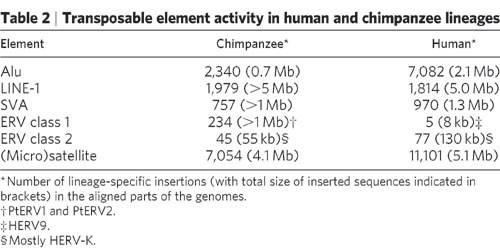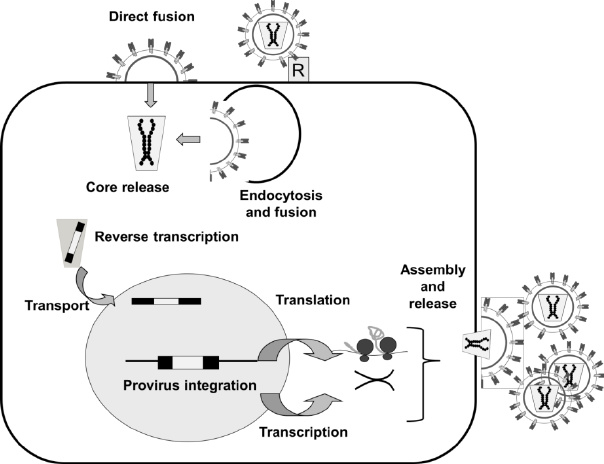Hence the tilde. Estimates are all over the map, depending on what is accounted for, etc.
What is your point now? Very few ERVs are unique to the human lineage, as in 22 out of 200,000:

What does this have anything to do with contradicting common descent?
The point is that the lack of endemic infectious retroviruses contradicts CD because they exist in other primates, and by CD inference, in our primate common ancestors. So they are in our ancestors but not us. You might say, "well, that is because Humans evolved some restriction systems. But that’s not true, because we have HIV now. So what we have is a violation of the expected CD pattern, and we need a new mechanism to fix the “anomaly.” This mechanism would, somehow, purge the early (earlier) human lineage of the endemic infectious retroviruses which we otherwise must have inherited from our primate ancestor. There’s always a fix, but with each fix, you have a parsimony cost.
So your point is that humans gained some kind of mechanism to help us (at some point after we split from other primates in the CD model) and thus the ERVs were from before this point which is exactly the model that we’ve been repeatedly speaking of… those 200,000 ERV insertions occurred in a common ancestral population. Why would such a mechanism remove previous ERVs that had already been integrated into our genome?
Another problem is that, when we hypothesize higher level mutations (which pretty much have to be hypothesized), you run into two problems: selection and serendipity:
Selection: Higher-level (regulatory type) mutations are more difficult to provide selectable fitness improvements. This is because they are advantageous in certain circumstances. I’m not saying this is always the case, but often, selection is going to be weaker. Of course you can call upon drift, but drift is a much weaker search engine.
Serendipity: If you get a human from a primitive, rudimentary, small, primate via higher-level mutations, that means all the underlying, foundational, hardware was already, a priori, in place, for the higher-level mutations to take operate on, and take advantage of. Its like having all the parts of a car constructed and assembled, and then a few random mutations supplies just the right screws and bolts, at the right places, and you then have a car. There is a lot of serendipity implied.
If your point is that there would be a selective advantage, yes, I agree. I’m not saying it wouldn’t be selected for. But it is an unknown mechanism that must have been there, which doesn’t seem to be doing its job against HIV, BTW. From the paper:
What do you imagine ‘purge’ means and how do you imagine this helps your argument? Or are you just getting excited that the phrase ‘unknown mechanism’ appears in an article by evolutionists? Or a third option? And how still does this help the nearly 200,000 we share with other primates?
It would help if we can avoid the condescension. I’m not imagining anything about their choice of terminology. Their meaning is clear in the paper. It is their term, not mine.
It doesn’t. It is another type of retrovirus evidence.
Deal. But can you at least explain to me, in as clear as English as possible, what you think the paper is saying that contradicts CD?
So I’m not sure what your question is getting at. I’m using the term “contradict” and perhaps your question is how can this contradict CD, genes go missing all the time and we don’t call it a contradiction, we merely say they were deleted. Why should these missing retroviruses be any different? I’ll assume that is the spirit of your question.
If you are a proponent of a theory (which you pretty clearly are in this case), there is a great temptation to avoid falsification and say “my theory can explain that,” in response to any observation. But this is like a drug, as while it feels good, it is corrosive to the theory.
This tendency happens in science, and it empties the theory of any meaning, and makes the theory unfalsifiable. In Bayesian terms, it reduces the probability of the theory because the prior conditional goes down. In model selection terms, the theory has way too many additional terms and is “overfitting.”
Evolution has gone down this road, and is thoroughly addicted to this drug. The literature is loaded with a practically endless sequence special explanations. For CD and phylogenies, practically anything can be explained. You can have extremely rapid evolution or stasis; you can have anagenesis or cladogenesis; you can have the same design appearing repeatedly out of nowhere, any number of times, sporadically in the tree; you can have elaborate designs just disappearing at any time or place in a tree.
The biological world is absolutely loaded with data that do not fit CD. The data do not form a tree. But with all of these add-on explanatory mechanisms, inevitably everything can be explained. The endemic infectious retroviruses are an example of this. Oh, they just disappeared somehow–see, we explained it using CD. What’s the problem?
In case you forgot, viruses also evolve. You can’t use modern susceptibility to make predictions of how these viruses behaved in the past.
Then how do you explain the physical differences between humans and chimps? What is causing it? If the phenotypic differences between humans and chimps is not due to the DNA sequence differences between our species, then what is the cause?
WHAT???
We know what the differences are because we have sequenced the vast majority of the chimp and human genomes. We also know what the mechanisms of mutagenesis are. These changes aren’t unknown. What we don’t know is which specific DNA differences are responsible for specific phenotypic differences. However, there is no doubt that among the DNA differences separating chimps and humans are the mutations responsible for human morphology.
I’m not seeing an answer to @pevaquark 's question. How does the paper you are citing contradict common descent, in your own words?
I also fail to see how this contradicts common descent. If humans evolved a feature that made them immune or much less susceptible to a specific virus, how does this contradict common descent? There are known human mutations that make us less susceptible to the HIV virus (e.g. CCR5 delta mutation). Does this also contradict common descent, in your eyes?
yes it does. since we know that retroviral parts can be created from the host parts- we can conclude that retroviruses created from host parts.
Barry and his blog may be helpful here for you:
Those retroviruses which emerge from the host genome infect other cells and then insert their viral DNA into the new host genome. That is where new ERVs come from. Insertion into the host genome is part of the life cycle of a retrovirus.
Added in edit:
Thought I might add a picture:

Agreed. You overlooked my point. Yes, we know the sequence differences. So we can make reasonable (i.e. reasonable according to evolution) inferences about the set of mutations that are going to create a human from a primitive, rudimentary, primate. My point is, its not going to happen. You aren’t going to traverse such a large phenotype distance with such minor genetic changes. Make those level of changes to any species today, make them as intelligent as possible. You’re not going to get that kind of result. That is what is indicated by the science.
Where was this science published?
What do you propose that would cover the phenotype distance if not genetic change?